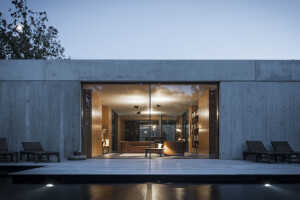A warm and glowing street eatery located in a dark Kyoto alleyway is the concept for Kusakabe, a Kaiseki style sushi bar designed and constructed by San Francisco based ArcHive designbuild, in conjunction with Fumio Suda Architect. The restaurant is located on the edge of historic Jackson Square, in San Francisco’s Financial District, across the street from the iconic Trans America Building. The design is also based on the idea of Wabi-sabi: the acceptance and celebration of impermanence and imperfection. The designers sourced locally reclaimed and salvaged wood for the interior finishes—the sushi bar consists of one continuous 30’ slab of salvaged Elm. The walls and soffit that define the alleyway are salvaged slabs of rock-hard Eucalyptus, which were painstakingly sanded to a lustrous sheen. Splits and cracks in the wood reveal its history and age. A main goal of the designers is for people to enjoy a tactile experience of the space—the smooth yet uneven surfaces of the wood invite the visitor to run their hands along them—to feel, as well as see. Sheets of bamboo plywood were used for the ceiling and floor, wrapping up the low wall of the bar. The clean lines of the bamboo stand in stark contrast to the organic nature of the adjoining woods, creating a space that is modern, yet at the same time has the feel of something ancient. The historic building’s original brick wall was left untouched. Along with the new concrete slab floor, it defines the alleyway, and its various patches and flaws further the idea of impermanence and change. The restaurant seats 32 patrons, the majority of whom sit at the sushi bar. ArcHive did away with the standard practice of the glass case dividing the chef from customer. Instead, the short backsplash and long cutting boards—made from salvaged Bay—become an extension of the bar. The relationship between chef and diner becomes one of intimacy; the fish is prepared inches from where the customer sits. The small dining area holds six tables, and is also a warm and intimate space. Horizontal planks of Eucalyptus stacked from floor to ceiling, along with the vertical screen made from the same wood, separate the dining area from the entry. A wall of natural plaster flanks the other side. The wood veneer pendant lights were designed and fabricated by ArcHive, in order to maintain the seamless quality of warm and glowing wood.























